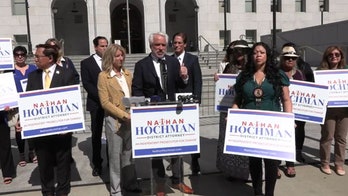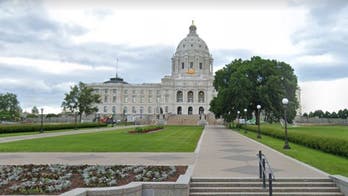Some good news.
The House will not begin taking up the contempt of Congress resolutions against Attorney General Eric Holder tomorrow morning at the same time as the health care opinions are handed down.
It will all start sometime after 12:30 p.m., and here’s what the process will look like.
For starters, there will be a lot of reaction around Capitol Hill on the health care decision all morning. House Speaker John Boehner, R-OH, has a presser scheduled for 11:15 a.m. House Minority Leader Nancy Pelosi, D-CA, goes at 12:15 p.m. The contempt activity won’t start until around 12:30 p.m.
The House will actually consider two contempt resolutions against Holder.
First of all, the House has the actual “criminal” contempt resolution that was voted on last week by the House Oversight Committee. If the House votes for that contempt resolution, the citation is sent to the Justice Department. A U.S. Attorney is then asked to look at the case and try to get an indictment of Holder for not responding to Congress.
Click here for the text of this document.
There’s also a “civil” contempt resolution. This citation was not approved by the Oversight Committee and an be found here.
The second resolution is interesting because, if adopted, it grants the House the ability to go to court to ask for an order that the Department of Justice be compelled to fork over the 'Fast and Furious' documents in question.
The House will then have to vote on both resolutions. It is conceivable, but not likely, that the House could approve one contempt resolution and not the other.
This means there will be separate sets of debate on both resolutions, followed by separate votes. Around 12:30 pm, the House will begin debate on the “rule" that manages how the body handles the contempt resolutions on the floor.
At this point, the House will begin discussing contempt, though it's not accurate to say the debate will only focus on the resolutions. Debate on the rule is often feisty and good for soundbytes and dip-ins.
After that debate is complete (should take about an hour), the House will go to a voting sequence. One of those votes will be on the rule. Once the House has approved the rule, it clears the way for the House to take up the contempt resolutions.
The criminal contempt is first. The rules committee has allocated 50 minutes of debate for that resolution. Then the House takes up the civil contempt resolution. The rules committee has allocated 20 minutes for that debate.
Then there is a small wrinkle.
The rules committee has allotted ten minutes of debate for a motion by Rep. John Dingellm D-MI, to kill the contempt process and send the resolutions back to the Oversight Committee.
Once all debate is wrapped up, the House will then vote on those three resolutions. The voting sequence may have some other votes shoehorned in.
So what is the timetable?
This will be very fast and loose, but remember, lawmakers want to get out of here early so they can make it to the congressional Baseball game at Nationals Stadium just a few blocks away.
Here is my loose judgment on how things will play out Iif they in fact start at 12:30 p.m. Times are somewhat fudged because hey, the timing around here isn’t exactly Swiss. After all it’s Congress.
12:30 p.m.: Rule debate.
1:45 p.m.: Finish rule debate. Go to vote sequence.
2:30 p.m.: Begin debate on criminal contempt resolution.
3:45 p.m.: Begin debate on civil contempt resolution.
4:15 p.m.: Begin debate on Dingell’s motion to refer resolutions back to committee.
4:30 p.m.: Begin vote sequence on all three issues.
5:15 p.m.: Final results on all three.
I anticipate there will be some sort of a protest by Democrats. There are rumblings that large numbers of Democrats, mostly from the Congressional Black Caucus, may walk out of the chamber during the debate or vote in protest. We’ll learn more on this tomorrow. This is not an unheard of tactic. In early August, 2007, Republicans (then in the minority) walked out of the House chamber late one night after they perceived that Democrats “stole” a vote from them on an appropriations bill.
I wouldn’t be surprised if we have some pressers afterwards.
Listed below is the process for contempt, much of which happens once the contempt resolutions have been approved.
1) The subpoenaed witness either refuses to show or refuses to answer a question.
2) The congressional committee decides to hold him or her in contempt and takes a majority vote to do to that. They issue a "contempt citation."
3) The contempt citation is presented to the full House. A member of the House must then offer a privileged resolution directing the Speaker of the House to send the matter to a U.S. Attorney.
4) The House debates and votes to adopt the resolution by majority vote.
5) The Speaker directs the House Legal counsel to present the facts in a document and he certifies it and sends the fact document to the U.S. Attorney.
6) The U.S. Attorney must convene a Grand Jury.
7) The Grand Jury reviews the fact document and may want to call witnesses to testify before it.
8) The Grand Jury, after its proceedings, decides to indict the individual [or not indict.]
9) If indicted, the U.S. Attorney then mounts a prosecution of the individual in a court of law.
10) The statute [written in 1857] which still governs the contempt of Congress process today, requires that the following case be made for conviction:
[a] The answers the individual refused to give to Congress must relate to a legislative purpose and [b] The answers must fall topically within the grant of authority made by Congress to that specific congressional committee.
11) The committee, through the prosecuting attorney, must make the case that their questions are pertinent.
12) The jury decides if the individual is guilty of contempt of Congress or not.
13) If the individual is convicted the statute sets out the mandatory punishment:
[a] a fine of up to $1,000 but no more and/or b] a jail sentence of up to one year, but no more.




